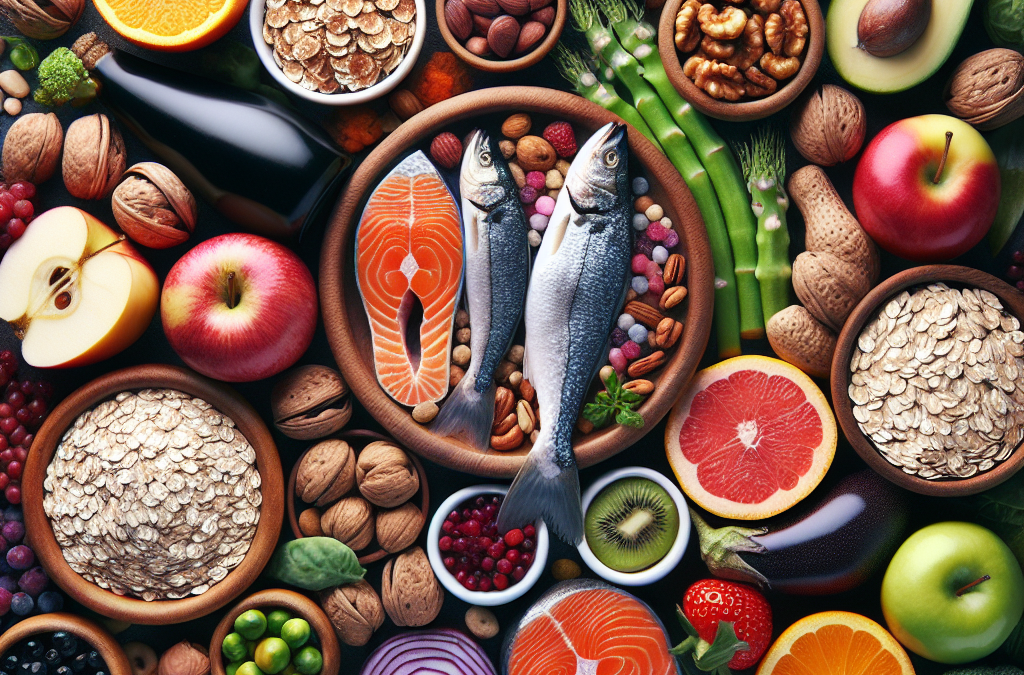1. Oats: The Breakfast Hero
Starting Your Day Right
Let me tell you, I have a love affair with oats. When I discovered that they could actually help lower cholesterol, it felt like I hit the breakfast jackpot. Oats are rich in soluble fiber, particularly beta-glucan, which helps reduce cholesterol absorption in the bloodstream. This means that by simply starting my day with a hearty bowl of oatmeal, I’m doing my heart a solid.
On days I’m feeling fancy, I toss in some fresh fruits like berries or slice up a banana. Not only do they add flavor, but they also contribute additional nutrients and fiber, making my morning meal even healthier. Plus, let’s be real, the colorful presentation just makes everything taste better.
Cooking up oats isn’t a hassle either. I usually prep them the night before if I’m running short on time in the morning—overnight oats are a game changer! Just soak them in yogurt or milk, add some toppings, and I’m ready to conquer the day with a heart-healthy kick.
Different Ways to Enjoy Oats
Oats aren’t just for breakfast; they can be a versatile addition to my meals. I love throwing them into smoothies for a creamier texture or using them as a thickener in soups and stews. They work perfectly to bulk up recipes and keep me feeling full longer, which is essential for reducing cravings.
I’ve also tried baking with oats. Oatmeal cookies? Yes, please! Just make sure to swap out refined sugars for healthier alternatives like honey or maple syrup, and you’ve got a treat that benefits your cholesterol levels too.
Don’t underestimate the power of oat flour, folks! It’s super easy to make by blending oats in a food processor. I often use it to replace regular flour in pancakes or muffins, which makes for a wholesome breakfast or snack that’s still delicious.
Choosing the Right Oats
Now, I’ve got to be a little picky when it comes to oats. Instant oats might be the quick and easy option, but they often come packed with sugars and preservatives. I tend to stick with rolled or steel-cut oats because they retain more nutrients and have a lower glycemic index, which helps keep my blood sugar stable.
Another tip I’ve picked up is to look for whole grain labels. This ensures I’m getting all the fiber and nutrients that whole oats offer. A good rule of thumb is to read the ingredient list and make sure “oats” is the first item listed—simple as that!
Remember, moderation is key. While oats are amazing, I like to balance them out with other food groups to keep my diet varied and interesting. Too much of a good thing can sometimes lead to dietary boredom!
2. Fatty Fish: Your Heart’s Best Friend
Choosing the Right Types
Fatty fish, like salmon and mackerel, have become staples in my weekly diet. The omega-3 fatty acids found in these fish are fantastic for heart health. They help lower triglycerides, reduce blood clotting, and can even improve arterial health. I mean, what’s not to love about that?
When shopping for fish, I always try to go for fresh or frozen options instead of canned ones, as they can contain added sodium and preservatives. I’ve found that fresh fish not only tastes better but also retains more nutrients.
Another aspect I enjoy is experimenting with various cooking methods. Whether grilling, baking, or pan-searing, getting those lovely, crispy edges always brings out the best flavors. Plus, it’s an easy way to impress friends who claim they don’t like fish!
Incorporating Fish into Meals
Now, integrating fatty fish into my diet doesn’t have to be a chore. I love tossing grilled salmon on top of a fresh salad or mixing it into a pasta dish for a healthy twist. And let’s not forget about fish tacos—so simple, yet so flavorful!
Besides adding fish to my plates, I sometimes get creative and use fish in spreads or dips. Smoked salmon on whole-grain crackers with a little cream cheese is one of my go-to snacks. It’s not only light but also packed with heart-healthy goodies.
And for those who are a bit squeamish about cooking fish, don’t worry! Many markets now sell already-prepped options that you can just throw in the oven or air fryer. Convenience is king, right?
Listening to My Body
When I upped my intake of fatty fish, I made sure to keep a check on how my body felt. Omega-3s can be gentle on the stomach, but if you’re not used to having fish regularly, it’s a good idea to ease into it. Personally, I didn’t experience any adverse effects, which was a relief!
I also became conscious about the sources of my fish. Sustainable practices are something I care about, so I seek out labels that guarantee environmentally-friendly fishing methods. This way, I’m also playing a part in preserving our oceans while contributing to my heart health.
At the end of the day, listening to my body has helped me make better choices regarding the balance of whole foods I consume. Fatty fish have definitely added that extra layer of health benefits to my diet.
3. Nuts and Seeds: Crunchy Little Powerhouses
Why They Matter
Nuts and seeds might just be the unsung heroes of a heart-healthy diet. These little powerhouses contain healthy fats, fiber, and a range of vitamins and minerals. I’ve always been a snacker, so incorporating them into my daily munching routine felt right.
Walnuts, in particular, have earned a special spot in my pantry. They are filled with omega-3s just like fatty fish, which contribute to lowering cholesterol. Almonds are another fave of mine due to their vitamin E content, which is excellent for heart health.
Don’t shy away from variety, though. I often mix different nuts and seeds in my own trail mix—think sunflower seeds, pumpkin seeds, or even chia seeds for that added crunch and rich nutritional benefit. The options are endless!
Perfect Pairings
Packing nuts and seeds in my diet hasn’t just meant snacking; they’ve become delightful additions to various meals. I love sprinkling ground flaxseed onto my smoothies for that nutritional boost or tossing chopped walnuts into salads for extra texture.
Sometimes, I enjoy making my own nut butter! Blending roasted almonds or peanuts with a drizzle of honey not only satisfies my sweet tooth but also keeps things healthy. It’s delicious on its own or spread on whole grain toast.
Incorporating seeds is just as easy. I often add chia seeds to my overnight oats or oatmeal, which not only helps thicken them but also packs a punch of omega-3s. It’s a win-win!
Watch Portions
While nuts and seeds are indeed healthy, portion control is crucial. I learned the hard way that it’s super easy to overindulge with them. Instead of pulling from the whole bag, I now pre-portion them into small containers or bags to keep my snacking in check.
Get an Amazing Discount on the Best Certified Organic Whole Food Supplement!
Another thing to keep in mind is to steer clear of salted or roasted varieties, as they can come loaded with unnecessary oils and sodium. Raw or dry-roasted nuts are always my first choice.
Balancing nuts and seeds with other food groups makes it easier to enjoy their health benefits without going overboard. It’s all about finding that perfect harmony!
4. Fruits and Vegetables: Nature’s Nutrient Bombs
Colors of the Rainbow
I can’t stress enough how important fruits and vegetables are for overall health, especially when it comes to lowering cholesterol. Each color brings unique nutrients and antioxidants, so I try to fill my plate with a variety of hues. Whether it’s vibrant berries, leafy greens, or juicy oranges, they not only look good but taste good too!
Did you know that fruits and veggies are also packed with fiber? Foods like apples, pears, and Brussels sprouts help keep cholesterol levels in check. I often find myself whipping up colorful salads and stir-fries just to enjoy all the different tastes and textures!
The beautiful aspect of incorporating fruits and veggies is their versatility. Whether I’m tossing them in a smoothie, grilling them for a side dish, or simply snacking on them raw, there’s always a way to include more in my meals.
Local and Seasonal Choices
Visiting farmers’ markets has become one of my favorite pastimes. Not only do I support local farmers, but I also get access to ultra-fresh produce that’s often higher in nutrients. Plus, seasonal fruits and veggies tend to pack more flavor—who can resist super sweet strawberries or crunchy snap peas?
I’ve learned a thing or two about what’s in season, and this prompts me to adjust my meals accordingly. Eating seasonally keeps my diet varied and exciting, while also encouraging me to explore new fruits and veggies that I might not typically choose.
Getting full use out of the produce I buy is also part of my strategy. If I end up with extra greens, I’ll toss them into soups or blend them into smoothies. No waste, just deliciousness!
The Power of Cooking Techniques
How I prepare fruits and vegetables can significantly impact their health benefits. I often steam my veggies instead of boiling them to retain maximum nutrients. A quick sauté with a drizzle of olive oil and some herbs really brings out their natural flavors and makes them all the more appealing.
On the fruits side of things, I love roasting or grilling them. Grilled peaches or pineapples add a sweet twist to my summer barbecues. It’s funny how a simple cooking technique can make such a difference!
With fruits, I’ve also embraced homemade sauces and jams. That way, I control the sugar content while enjoying the incredible flavor they bring to my yogurt or breakfast toast. Every bite is packed with love for my heart!
5. Legumes: The Protein Powerhouses
Healthy Protein Alternatives
When I decided to reduce my meat intake, legumes became a cornerstone of my diet. They’re a fantastic source of plant-based protein, which is essential for maintaining energy levels. Beans, lentils, and chickpeas are now my go-to options for boosting my meals without relying solely on meat.
Not only do legumes offer protein, but their high fiber content helps lower cholesterol levels. I love whipping up hearty bean soups or chickpea salads that not only fill my belly but also nourish my heart. Plus, they’re super easy to prepare, especially if you buy them canned or frozen.
Worried about how to cook them? I often throw some lentils into a pot with water or broth and let them simmer for half an hour. The results are delicious and easy, making them perfect for busy days when I don’t want to fuss in the kitchen.
Versatile Culinary Uses
Legumes really shine in their versatility across various cuisines. I love making hearty chili with kidney beans or Mediterranean hummus with chickpeas. They act as an excellent base for so many dishes, and I’m all about experimentation—like tossing black beans into tacos or lentils into a veggie burger mix!
One of my favorite tricks is using legumes to thicken soups and stews while adding nutrients. They create a creamy texture without needing heavy creams or thickeners. Smart and nutritious, if you ask me.
I’ve also started using legumes in my breakfast routine. Yes, you heard that right! Adding black beans to my morning scramble is a tasty way to kick-start the day with extra protein and fiber.
Mindful Eating Practices
Shifting my diet to include more legumes was a bit of an adjustment initially. I discovered the importance of mindful eating and listening to my body. Legumes can be tricky for some folks’ digestion, but taking my time to enjoy meals and chewing thoroughly can make a world of difference.
Also, soaking dried beans the night before helps reduce that bloated feeling many people experience. It’s a small step, but it has made my meals a lot more enjoyable!
Overall, legumes have become a staple in my home, and finding ways to incorporate them into my diet is both fun and fulfilling. They not only support my heart health but also maintain my energy levels throughout the day.
Frequently Asked Questions
1. What are some other healthy food options for lowering cholesterol?
While oats, fatty fish, nuts, seeds, fruits, vegetables, and legumes are among the best whole foods, other options include whole grains, avocados, and grapefruits. Each of these foods contributes to better heart health in different ways!
2. How often should I consume these foods to receive benefits?
Incorporating a variety of these foods into your daily diet is ideal. Aim for at least one serving of fatty fish a couple of times a week, daily oats, and a colorful mix of fruits and veggies in every meal to maximize their health benefits.
3. Are there any foods I should avoid to maintain healthy cholesterol levels?
Avoiding processed foods, high-sugar snacks, and saturated fats can significantly improve your cholesterol levels. Oils like palm oil and excessive red meat should also be limited to promote heart health.
4. Can I still eat meat if I want to lower my cholesterol?
Absolutely! Choosing lean meats and incorporating plant-based proteins, like legumes, can keep your meals balanced. Remember to watch your portions and focus on healthier cooking methods.
5. How long does it take to see results from dietary changes?
Results will vary from person to person. However, several studies show that individuals often see noticeable changes in cholesterol levels within a few weeks to a few months after making significant dietary changes.




